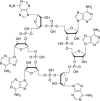Putative nucleotide-based second messengers in archaea
- PMID: 37305433
- PMCID: PMC10249747
- DOI: 10.1093/femsml/uqad027
Putative nucleotide-based second messengers in archaea
Erratum in
-
Correction to: Putative nucleotide-based second messengers in archaea.Microlife. 2023 Sep 27;4:uqad039. doi: 10.1093/femsml/uqad039. eCollection 2023. Microlife. 2023. PMID: 37771611 Free PMC article.
Abstract
Second messengers transfer signals from changing intra- and extracellular conditions to a cellular response. Over the last few decades, several nucleotide-based second messengers have been identified and characterized in especially bacteria and eukaryotes. Also in archaea, several nucleotide-based second messengers have been identified. This review will summarize our understanding of nucleotide-based second messengers in archaea. For some of the nucleotide-based second messengers, like cyclic di-AMP and cyclic oligoadenylates, their roles in archaea have become clear. Cyclic di-AMP plays a similar role in osmoregulation in euryarchaea as in bacteria, and cyclic oligoadenylates are important in the Type III CRISPR-Cas response to activate CRISPR ancillary proteins involved in antiviral defense. Other putative nucleotide-based second messengers, like 3',5'- and 2',3'-cyclic mononucleotides and adenine dinucleotides, have been identified in archaea, but their synthesis and degradation pathways, as well as their functions as secondary messengers, still remain to be demonstrated. In contrast, 3'-3'-cGAMP has not yet been identified in archaea, but the enzymes required to synthesize 3'-3'-cGAMP have been found in several euryarchaeotes. Finally, the widely distributed bacterial second messengers, cyclic diguanosine monophosphate and guanosine (penta-)/tetraphosphate, do not appear to be present in archaea.
Keywords: archaea; cyclic diadenylate; cyclic oligoadenylate; second messenger; signaling.
© The Author(s) 2023. Published by Oxford University Press on behalf of FEMS.
Conflict of interest statement
None declared.
Figures



Comment in
-
Correction to: Putative nucleotide-based second messengers in archaea.Microlife. 2023 Sep 27;4:uqad039. doi: 10.1093/femsml/uqad039. eCollection 2023. Microlife. 2023. PMID: 37771611 Free PMC article.
Similar articles
-
Putative Nucleotide-Based Second Messengers in the Archaeal Model Organisms Haloferax volcanii and Sulfolobus acidocaldarius.Front Microbiol. 2021 Nov 22;12:779012. doi: 10.3389/fmicb.2021.779012. eCollection 2021. Front Microbiol. 2021. PMID: 34880846 Free PMC article.
-
Cyclic nucleotides in archaea: Cyclic di-AMP in the archaeon Haloferax volcanii and its putative role.Microbiologyopen. 2019 Sep;8(9):e00829. doi: 10.1002/mbo3.829. Epub 2019 Mar 18. Microbiologyopen. 2019. PMID: 30884174 Free PMC article.
-
Recent advances and perspectives in nucleotide second messenger signaling in bacteria.Microlife. 2023 Apr 17;4:uqad015. doi: 10.1093/femsml/uqad015. eCollection 2023. Microlife. 2023. PMID: 37223732 Free PMC article. Review.
-
The ever-expanding world of bacterial cyclic oligonucleotide second messengers.Curr Opin Microbiol. 2021 Apr;60:96-103. doi: 10.1016/j.mib.2021.01.017. Epub 2021 Feb 25. Curr Opin Microbiol. 2021. PMID: 33640793 Free PMC article. Review.
-
Cyclic di-AMP: Small molecule with big roles in bacteria.Microb Pathog. 2021 Dec;161(Pt A):105264. doi: 10.1016/j.micpath.2021.105264. Epub 2021 Oct 29. Microb Pathog. 2021. PMID: 34715302 Review.
Cited by
-
Structural and Evolutionary Analysis of Proteins Endowed with a Nucleotidyltransferase, or Non-canonical Palm, Catalytic Domain.J Mol Evol. 2024 Dec;92(6):799-814. doi: 10.1007/s00239-024-10207-7. Epub 2024 Sep 19. J Mol Evol. 2024. PMID: 39297932 Free PMC article.
References
-
- Athukoralage JS, White MF. Cyclic nucleotide signaling in phage defense and counter-defense. Annu Rev Virol. 2022;9:451–68. - PubMed
Publication types
LinkOut - more resources
Full Text Sources
